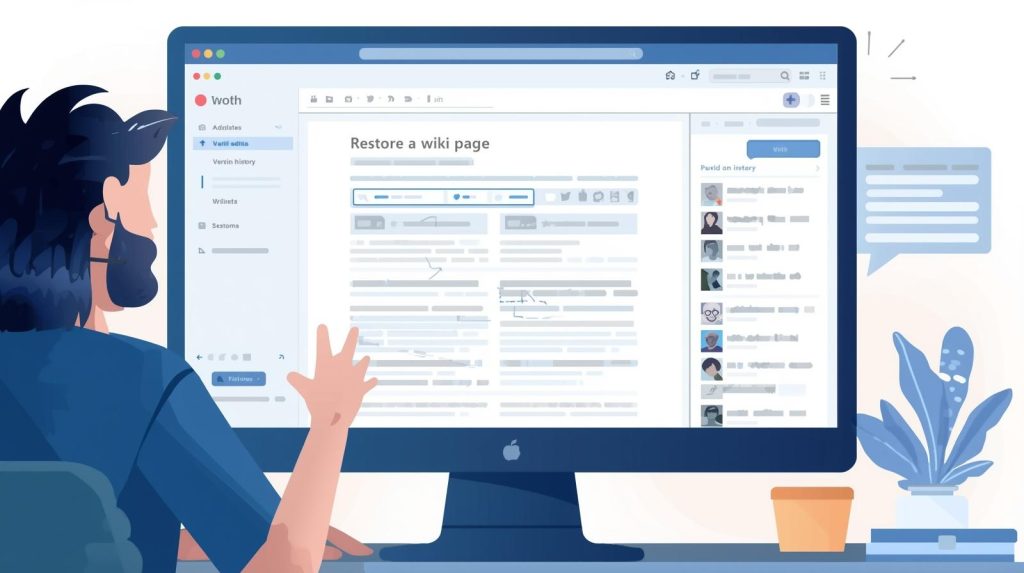Wiki pages can feel permanent until they’re not. A single edit or deletion can erase years of careful work in minutes. This happens daily, with pages about brands, public figures, and organizations being flagged, edited, or removed.
Because Wiki ranks high on search engines, losing or damaging a page can quickly hurt your image. Readers often assume a missing page means the subject is unimportant or untrustworthy, which can be a public relations headache for companies, authors, and public figures.
Wiki page protection services are crucial for defending against vandalism. Knowing how to recover a deleted page is also vital, as it allows you to restore content, citations, and history before false information can spread.
In this guide, you’ll learn how to:
- Recover deleted pages.
- Restore pages after heavy edits.
- Prevent vandalism on a Wiki page before it becomes a crisis.
By the end, you’ll have a roadmap to keep your page safe and credible without violating Wiki’s rules.
Understanding Wikipedia Page Deletion & Editing Policies
Before you can recover or protect a page, you need to understand why and how pages disappear or change. The platform is built on community-driven rules that determine which pages stay, get edited, or are deleted. Knowing these rules saves time and frustration.
Types of Deletion
Wiki has three main types of deletion:
- Speedy Deletion: An administrator can perform this immediately if a page clearly violates basic policies, such as blatant advertising or a lack of credible sources.
- Proposed Deletion (PROD): An editor tags the page, and if no one objects within seven days, it’s deleted.
- Articles for Deletion (AfD): This is a full debate where editors discuss whether the page meets notability and sourcing standards. The outcome depends on a community consensus.
What Happens When a Page Is Deleted or Heavily Edited
When a page is deleted, the content isn’t gone forever. It’s hidden from public view but still stored in Wiki’s system, accessible only by administrators.
If a page is heavily edited, all previous versions are stored in the revision history. This means you can review, compare, and often restore old content.
Key Terms Explained
- Deletion Logs: A public record showing which pages were deleted, by whom, and for what reason.
- Revision History: A timeline of every change made to a page.
- Requests for Undeletion: A formal process to ask administrators to restore a deleted page you believe was removed unfairly.
How to Recover a Deleted Wikipedia Page
Now that you understand how deletion works, let’s talk about the action you can take. Recovering a deleted Wiki page might sound intimidating, but the process is public and rule-based.
Step 1: Check the Deletion Logs
First, open the deletion log for your page by typing “Special:Log/delete” into the search bar followed by your page title. This will show you why, when, and by whom the page was deleted, helping you plan your next move.
Step 2: Review the Revision History
Even if a page is gone, its earlier versions often remain in the revision history. Compare these versions to identify which parts met Wiki’s standards and which triggered the removal. This information will guide your restoration request.
Step 3: File a Request for Undeletion
If you believe the deletion was unfair or premature, you can submit a Request for Undeletion at Wiki’s “Requests for undeletion” noticeboard. Clearly explain why the page meets the notability and sourcing guidelines, and link to reliable citations. It is crucial to keep your tone neutral and factual.
Step 4: Contact an Administrator or Experienced Editor
If the process stalls, politely contact the administrator who deleted the page or an experienced editor active in that topic area. They can clarify what went wrong and how to fix it.
Step 5: Consider a Wikipedia Page Restoration Service for Complex Cases
When Wiki rules or debates get tricky, it can be smart to call in a professional. These services know the rules and can guide you safely. They can also create and submit neutral drafts that have a higher chance of success.
Step 6: Use Archived Versions
If your page had unique content, check the Wayback Machine or similar archives. These tools store snapshots of websites, including Wiki pages, and can help you recover text or references for a new, compliant draft.
By following these steps, you maximize your chances of restoring your page.
Restoring Pages After Major Edits
Sometimes a page isn’t deleted, but it’s edited so much that it’s no longer accurate. Biased wording, outdated facts, or missing sections can quietly erode a page’s credibility. Acting quickly can protect both your reputation and the information readers see.
Spot and Undo Unwanted Edits
Monitor your page’s revision history. Each entry shows who changed what and when, making it easy to spot unwanted or biased changes. Wiki stores every version of a page, so if a damaging edit appears, you can compare versions side by side and click “undo” or “rollback” to restore the earlier text.
Engage with Other Editors Respectfully
If you see an edit war brewing, pause and use the page’s “Talk” section to explain why you are restoring the content. Provide links to solid sources and relevant rules to back up your actions. This helps de-escalate conflicts and makes your edits more likely to stick.
Preventing Vandalism on Wikipedia Pages
It’s easier to stop damage before it happens. Vandalism can be obvious (offensive words) or subtle (small factual errors). Knowing how to prevent it saves time and stress.
Use Best Practices to Minimize Risk
Add strong, verifiable sources to every statement on your page. Reliable citations discourage vandals and give other editors confidence in your content.
Request Page Protection When Needed
Wiki allows you to request different levels of page protection:
- Semi-protection: Limits editing to established users.
- Full protection: Locks a page so only administrators can edit it.
You can make these requests at the “Requests for page protection” noticeboard. Explain why protection is needed, link to examples of vandalism, and be polite.
Work With the Community and Services
Engage politely with other active editors on your page’s “Talk” section. Good relationships can lead to faster help when vandalism occurs. For high-profile or frequently targeted pages, professional page protection services can monitor your page and quickly request protection.
Long-Term Protection
Long-term protection keeps your page stable even when you aren’t monitoring it daily.
Build a Strong Foundation
Pages with strong, reliable sources are harder to change or delete. Moving from weak sources to solid evidence is the first step to keeping a page stable.
Use Watchlists and Alerts
Wiki has built-in tools to monitor changes. Add your page to your watchlist to get notifications whenever someone edits it. You can also enable email alerts for faster responses.
Employ Bots or Monitoring Tools
Some volunteer bots automatically flag obvious vandalism and can even revert it instantly. You can also use third-party monitoring tools for deeper analytics.
Hidden Costs & Pitfalls
When you compare quotes for
- Wikipedia page writing
- Wikipedia editing
Basically, the numbers often look neat and simple. However, there are charges and risks. Knowing them upfront? That keeps you from nasty surprises later.
Firstly, extra fees often appear for
- images
- info boxes
- special formatting
Plus, adding media isn’t just copy-paste. But it requires
- verifying licenses
- meeting Wiki’s copyright rules.
Hence, providers may bill separately for this step.
Secondly, changes can cost more than expected. Now, some packages include only one or two edits. That’s it! And after that? Well, each round of changes may trigger an extra fee.
Finally, choosing the wrong editor? this can lead to bigger problems. For instance, what if they break Wiki’s rules? UGH! Your page can be deleted fast. Also, it can spark public disputes on the talk page.
So, always, check their track record before signing a contract.
DIY vs. Professional Help
Wiki is open for anyone to edit, but that doesn’t mean every tricky situation should be handled alone. Knowing when to do it yourself and when to get expert help saves time and prevents repeated deletions.
When You Can Do It Yourself
For small fixes like adding sources, correcting facts, or undoing simple vandalism, you can handle it on your own. You can also file simple “Requests for Undeletion” or ask for semi-protection yourself.
When Professional Help Makes Sense
Pages under repeated attack, high-profile bios, or articles stuck in policy debates often need more skill. Professional restoration or protection services know the rules, speak the community’s language, and write neutral content that lasts.
Pros of Outside Help:
- Deep knowledge of rules.
- Faster responses during disputes.
- Ability to draft neutral, compliant text.
Cons of Outside Help:
- Costs more than doing it yourself.
- You lose some direct control of edits.
Common Mistakes That Lead to Deletion
Good intentions often backfire on Wikipedia. Pages disappear or get vandalized because creators skip basic rules.
- Unsourced Content: Promotional language or unsourced claims quickly trigger deletion. Keep text neutral and verifiable.
- Breaking Rules: Biased wording and weak references make pages look unreliable. Follow Wiki’s core policies on Neutrality, Notability, and Verifiability.
- Failing to Monitor: Publishing a page and walking away leaves it open to misinformation. Use watchlists and alerts to catch changes early.
- Ignoring the Community: Not responding to talk-page questions or deletion notices can sink a page. Be polite and active to build trust.
Avoiding these pitfalls will drastically reduce the risk of deletion or distortion.
Conclusion
A healthy Wikipedia page is like a garden: it stays strong when it’s watched, sourced, and protected. By learning how to recover content, restore pages after edits, and prevent vandalism, you maintain control of your public footprint.
While many issues can be handled on your own, knowing when to enlist professional help for complex cases ensures that your page remains accurate, neutral, and trusted. By combining strong sources, smart tools, and proactive monitoring, you can build lasting protection for your online reputation.
Frequently Asked Questions (FAQs)
First, check the deletion log to understand why the page was removed. Then, review the revision history for past versions. Finally, file a formal Request for undeletion, providing reliable citations to prove the page’s notability. For complex cases, a professional restoration service can be beneficial.
Use strong, verifiable sources for all content to discourage casual vandalism. Monitor the page by adding it to your watchlist. If the page is a frequent target, request semi-protection or full protection from a Wiki administrator. For high-profile pages, professional services can provide ongoing monitoring and swift action.
A Wikipedia page restoration service is a professional service that helps recover deleted or heavily edited pages. You should use it when dealing with complex policy disputes, repeated vandalism, or when you need expert guidance to ensure your page is compliant with all of Wiki’s rules.
Disclosure: We are a dedicated content marketing agency guiding small and medium businesses through their journey to the first page of Google.

Admin at Search Marketing Experts, publishing insightful blog posts on SEO, digital marketing, and strategies to help businesses grow online.

